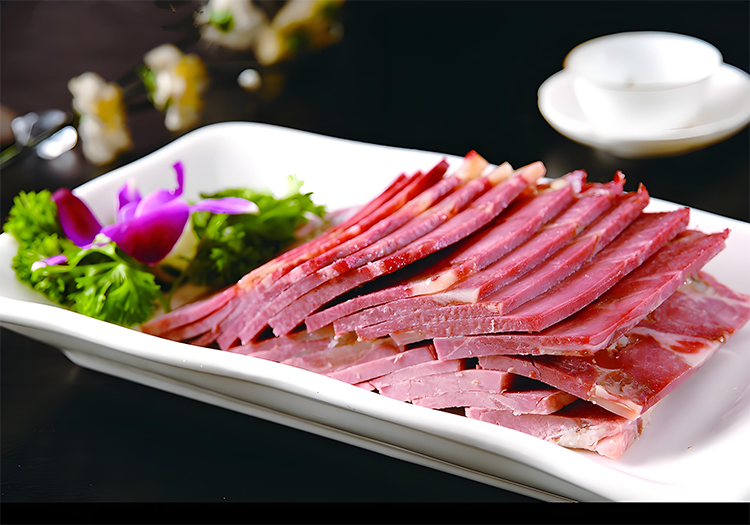Henan Duozi Meat: Six-Century Pressed Meat Tradition
Introduction
Imagine a slab of meat refined by dozens of steps and several days into a dense, glossy “meat brick.” Sliced thin, its grain shows through and each bite delivers a firm, savory, and elastic texture. This is not ordinary braised meat but Henan’s traditional specialty—Duozi Meat—a culinary artifact carrying centuries of Central China’s food wisdom.
1. Origin History: A Military Invention from the Ming Dynasty
Duozi Meat traces back to the Ming dynasty, more than six centuries ago. The most common origin story links it to army camps in the Central Plains, where soldiers needed a durable, portable meat supply. Whole beef or lamb pieces were heavily seasoned, cooked, then pressed under weight to remove excess moisture and form a compact block resistant to spoilage. The method solved storage problems and proved delicious, spreading from military use into local households and evolving into today’s banquet delicacy. The name “duozi” evokes the stacked, pressed final form.
2. Cultural Meaning: A Stately Dish for Central Plains Feasts
On the vast Central Plains, food culture is hearty and ceremonial. Duozi Meat reflects regional values—practicality, respect for guests, and rich hospitality. In times when resources were scarce, presenting Duozi Meat signaled abundance and sincerity. It remains a staple at important festivals and events—Spring Festival, weddings, and funerals—where its presence signals honor and serious hosting. Tasting it is as much a cultural experience as a culinary one.

3. Ingredients and Production: Time and Force Create the Essence
The charm of Duozi Meat lies in careful ingredient selection and labor-intensive craft.
- Core ingredients: high-quality beef (often beef shank) or lamb with firm muscle and clear connective tissue. A secret spice mix typically includes Sichuan pepper, star anise, cinnamon, clove, fennel, salt, and soy sauce.
- Complex process: making authentic Duozi Meat takes patience and skill.
- Marinating: The whole piece is thoroughly rubbed with spices and salt, then marinated for a day to let flavors penetrate.
- Binding and simmering: The marinated meat is tightly tied, then slowly simmered in an aged broth until tender yet still shapely.
- Pressing and shaping: The hot meat is packed into round or square wooden molds, covered, and pressed with heavy weights (traditionally stones) for one to two days. This step locks in juices and compacts the meat into a firm, unified block.
- Final product: After removing the weight and mold, the result is a cohesive, glossy reddish block ready to slice.
4. Flavor and Texture: Firm, Salty, and Deeply Satisfying
A well-made Duozi Meat is visually appealing—glossy mahogany in color—and can be sliced paper-thin to the point of translucence. The immediate taste is savory and well-seasoned; the spice blend adds layered aroma without overpowering the meat. Texture is the hallmark: remarkably firm and elastic, with muscle fibers that resist but yield pleasantly under the teeth—never dry or stringy. The longer you chew, the richer the meat flavor becomes. Duozi Meat is a “slow food” experience: its depth comes from time and technique.

5. How to Eat and Tasting Suggestions
Duozi Meat is versatile but tastes best cold.
- Classic serving: Slice thin and serve as a cold appetizer—no dipping sauce required to appreciate the cured flavor and texture.
- Creative pairings: Sandwich thin slices in a warm baked flatbread or steamed bun—contrast between cool, dense meat and soft, hot bread is delightful. It also pairs excellently with a glass of baijiu or local beer.
- When to eat: Serve it at the start of a meal as a cold platter to awaken the palate. Because of its richness, a few slices are enough to enjoy.
6. Traveler Tips: Where to Find Authentic Duozi Meat in Henan
Food travelers to Henan should look beyond upscale restaurants. Authentic Duozi Meat is often found in old neighborhoods, traditional markets, and time-honored deli shops in cities like Kaifeng, Zhengzhou, and Luoyang.
- Look for whole, rounded Duozi blocks on the shop counter—that’s a sign of traditional preparation.
- Ask for slices cut to order and request a warm flatbread if you want the classic sandwich pairing.
- Pair tasting with a bowl of local spicy-sour HuLa soup or millet porridge to balance richness.
- For souvenirs, vacuum-packed Duozi Meat keeps well and makes a memorable regional gift.

7. Home-Friendly Method: A Simple Family Version
If you want to recreate the idea at home, try this simplified approach:
- Choose a tidy beef shank piece.
- Marinate several hours with soy sauce, cooking wine, scallions, ginger, and a commercial braise spice pack.
- Simmer 1.5–2 hours until fork-tender.
- Wrap tightly in cling film into a cylinder shape, refrigerate, and press overnight with a heavy pot.
- Unwrap and slice thinly. It won’t fully match aged-broth depth, but you’ll get the firm, savory texture.
Conclusion
Henan Duozi Meat is a substantial culinary tradition—substantial in weight and in history. From a practical military solution in the Ming era to a refined banquet staple, it embodies time-honored Central Plains culinary wisdom. When you visit Kaifeng’s night markets or stroll Zhengzhou’s old streets, seek out this humble yet storied meat—slice a few pieces, pour a little local spirit, and taste centuries of Henan.


